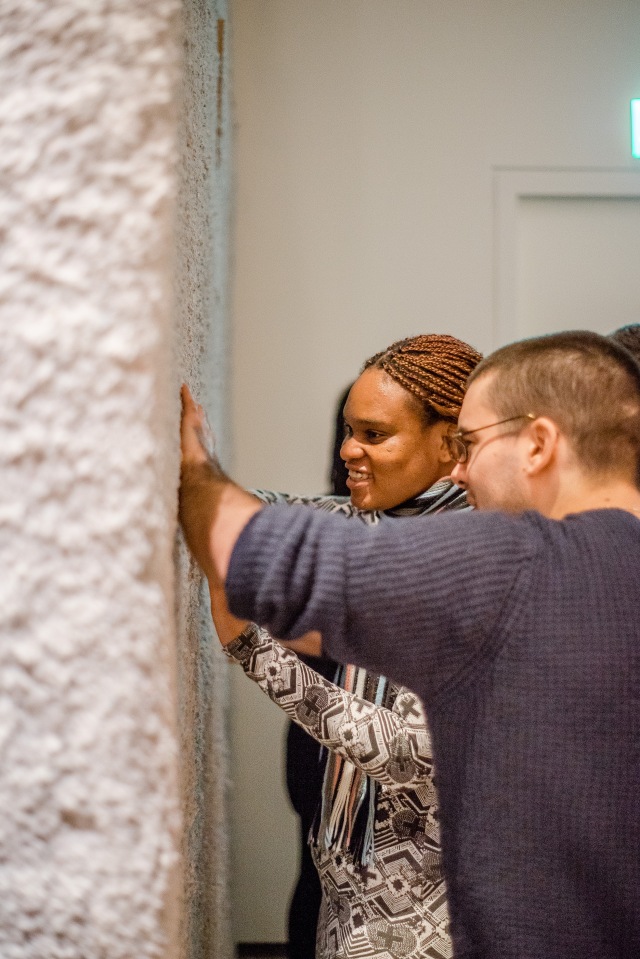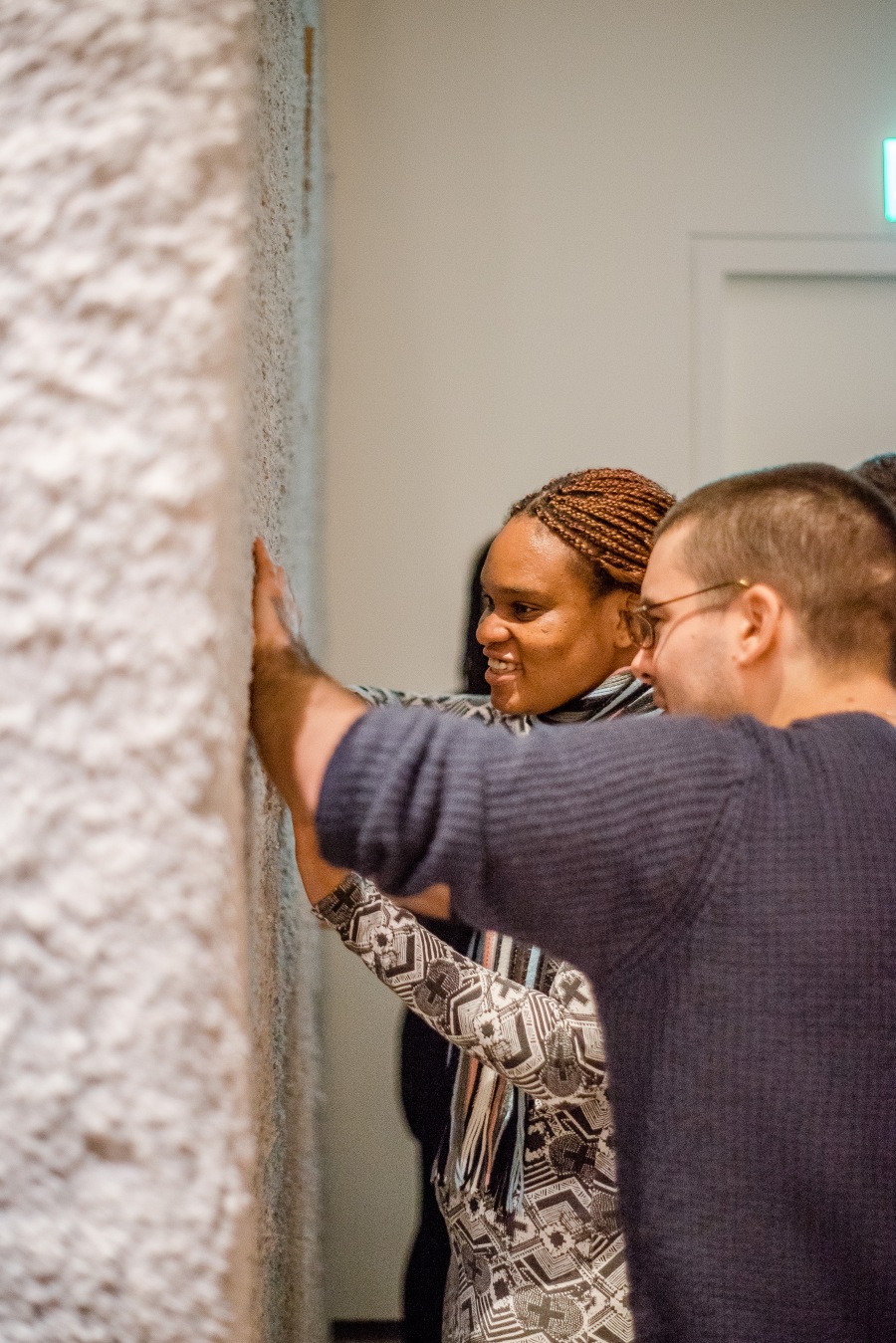The Design Museum
Saturday 18 November 2017
A Multisensory tour | Blog
Beazley Designs of The Year exhibition
Every year, the Design Museum recognises worldwide excellence in design through its Beazley Designs of The Year exhibition. This year, the tenth year in the series, showcases some of the most original and exciting products, concepts and designs from the following six categories; Architecture, Digital, Fashion, Graphics, Product and Transport.
The tour provided our visually impaired participants with valuable insight into many of the thoughts and criteria behind current designs and concepts, and ended with the unique opportunity to explore a few original objects from the exhibition in our handling session at the end of the tour.

Design is all around us and affects everything we do. Will designs be the brilliant breakthrough expected, or are some just absurd experimentations? Are the expectations of some designs realistic and valuable enough for the amount of development and time put to them? Underpinning MaMoMi’s multisensory approach are a focus on the interpretation of the available information, as well as collective participation, and we continue to express and demonstrate these values in our practice.
The Tour
For this tour and workshop session, we explored four exhibits; Meet Graham, Scewo, Gita, and Nike Pro Hijab, and toured the Play Space.
Meet Graham is an interactive lifelike sculpture demonstrating human vulnerability and the bodily features that would be needed to withstand a car crash. This is partly an educational tool and partly an unforgettable public service announcement.
Meet Graham was not installed as part of the exhibition but a short film demonstrated the making and workability of the concept. It is a grotesque depiction of how a human body would need to be formed in order to best withstand a car accident. It’s features include a flat, flabby face, tough skin, a barrel-like chest and a torso like an airbag.

Image: Meet Graham
Credit: Transport Accident Commission
Scewo is a futuristic looking wheelchair. It is a self balancing mobility device designed by a group of students and it enables wheelchair users to reach locations that were previously inaccessible. It is designed to sit up like a regular wheelchair and has a joystick and controls attached to the end of the handlebar. The user can also use a shift in body weight to control the chair.
It has two large wheels to drive around on flat ground and an extra pair of wheels at the rear of the chair allows users to raise the chair up so that they can engage with others at eye level. It also has rubber tracks that can be lowered to the ground for increased traction, allowing it to smoothly go up and down stairs safely, even on spiral stairs. Transitioning on and off the stair is automated and accomplished by the push of a button. The design also allows for many adjustments in the seating position. Scewo is still a prototype and under active development and was viewed via a short film.

Image: Scewo
Credit: Scewo
Gita is a robotic personal helper that carries your belongings. The company behind the Vespa scooter have made its first move into autonomous transportation with this robotic personal helper that carries your belongings for you. The two-wheeled Gita is a cargo vehicle that can track its owner and roll along behind them. It looks like a drum with two bicycle wheels attached to the outer parameter, allowing it to roll along as it navigates space.
Access to the storage compartment is via a small secure and lockable lid at the top which can be opened by a slight touch, and with a tap of a button, Gita can follow you. It is approachable and communicative, using lights, sounds and a touchscreen interface to stay in touch. Gita is tracked at all times and has a 360 degree camera.

Image: Gita
Credit: Piaggio Fast Forward
Nike Pro Hijab is a performance hijab by Nike that will potentially change the face of sport for Muslim women. Over recent years, meetings with top-flight athletes illuminated performance problems associated with wearing traditional hijab during competition. Specific issues with previously used garments included the garment’s weight, the potential for it to shift during action and the lack of breathability would usually disrupt the focus of the athletes during competitions.
Nike’s design team combined this information with existing Nike innovations to create the initial prototype hijabs. Equipped with the feedback and collected insight from Nike elite athletes, Nike’s design is constructed from durable single-layer Nike Pro power mesh, a breathable lightweight polyester fabric that features tiny, strategically placed holes for optimal breathability but remains completely opaque, and a soft touch. The mesh is also stretchy, so when combined with an elastic binding it allows for a personalised fit that adapts to both the wearers head and sport. Fluff threads used at the neck eliminates the rubbing and irritation that can occur when an athlete sweats. It was unveiled two days before International Women’s Day.

Image: Nike Pro Hijab
Credit: Nike
The exhibition tour ended with a visit to the Play Space where Nimuno Loops is installed. The Nimuno Loops tape was developed to allow Lego builders to place their creations on the walls, the ceiling, furniture and pretty much anywhere. It can be cut and can bend sideways as well. It is an extension of playing with Lego and allows for an even more creative engagement with an abundance of possibilities.
Participants were able to deconstruct, rearrange and reconstruct the play space, and this very tactile experience was truly useful as it provided opportunities for play. This also initiated the discussion around creativity through responsive design. Interestingly though, the Nimuno Loops was not developed or even officially sanctioned by the Lego company, and it is a curiosity to see how Lego responds to the increased creative functionality this sticky tape offers the Lego bricks and it’s other components.
Image: The six images posted show visually impaired participants and our sighted guides visiting the Beazley Designs of The Year exhibition.
The Workshop
The workshop session was an opportunity to physically explore some objects from the exhibition. Our handling resources included a sample of the paper mache wall, the Nike Pro Hijab, the Nimuno Loops and a few Lego brick objects.
The Nike Pro Hijab is exactly what it says it is. Constructed from durable single-layer Nike Pro power mesh, it is a breathable lightweight polyester fabric that features tiny, strategically placed holes for optimal breathability but which still remains completely opaque, and soft to the touch. Visually Impaired participants explored the hijab’s stretchy mesh which, combined with an elastic binding, allows for a personalised fit that adapts to both the wearers head and sport. At the request of the athletes, the designers placed a signature Nike swoosh just above the left ear to highlight the hijab’s pinnacle performance nature.
The paper mache wall has sustainable and recyclable qualities, and also meets the design criteria for the exhibition, exploring forward thinking methods for exhibition design and installations. This neutral coloured paper mache is a composite material consisting of paper pulp and bound with an adhesive. The sample we explored was a cut out from the actual installation and was evidence that though the exposed surface felt a bit fragile, it would actually withstand a good amount of physical handling. The rough surface felt like it would chip off easily but it remained firmly fixed on the wall. The composite material has benefits that include sound and heat insulation, and its sustainability and recyclable qualities means that when the exhibition finally closes, it will be easy to recycle. You may also perceive a soft fragrance in the paper mache, depending on the make up of the pulp.
We began to deconstruct and reconstruct the Lego brick objects, using the Nimuno Loops to create interesting variations of the objects, and making use of the tactility of the sticky tapes to rearrange the orientation and usability of the Lego bricks. This provided a really fun experience for our visually impaired participants.


The Next Tour
The next tour is the DESIGNER MAKER USER Tour: the USER experience.
This tour and workshop session will hold on Saturday 13 January 2018, from 11:00 – 12:30.
We will continue our exploration of the Designer Maker User exhibition, and investigate design and the user experience. One question is, how does design interact with our senses, as users? A workshop session will allow participants to co-design new objects that respond to the themes discussed.
This is a free tour but booking is necessary. Please book by visiting the Design Museum website, via the link here Designer Maker User tour.
Please meet in the atrium at 10.45am.
Credits
Multisensory Tour Facilitator: Andrew Mashigo.
Tour Programmer: Bernard Hay, Producer Adult Learning, Design Museum.
Large Print Guide: MaMoMi.
Image credits: MaMoMi Images, except where mentioned otherwise.
Photography: Ryan Prince Art, for MaMoMi Images © All rights reserved
Copyright © The Design Museum 2017










